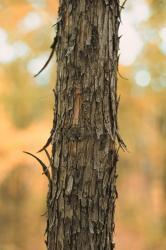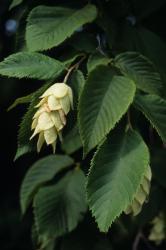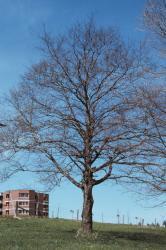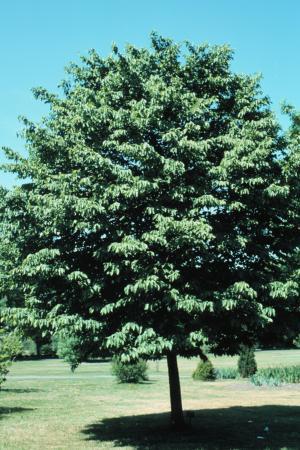June 11, 2013
| Ostrya virginiana Ironwood or Hop-Hornbeam
|
| Description | The attractive ironwood will dependably grow into a small, trouble free tree in many types of urban conditions while contributing interesting fall colour, winter form and food for wildlife. |
| Usage | Shade tree, street tree, tree lawn, reclamation, parking lot island. |
| Origin | Eastern North America |
| Hardiness zone | 3 |
| Size | 7-12m |
| Form/texture | Small tree with distinct trunk, pyramidal shape aging to a wide spreading crown and long slender branches; fine texture. "Bark thin, grayish brown, with numberless fine, flaky, plate-like scales, often with discernible twist" (Peattie). |
| Growth rate | Slow. |
| Leaf | Alternate, simple; showy yellow fall colour. |
| Flower | Monoecious; male catkins visible throughout winter. |
| Fruit | ".... the hop-like scales around the nut make it look as though the fruit were enclosed in little papery bags ..." (Peattie). Food for many animals. |
| Exposure/culture | Sun or shade. Tolerant of poor conditions; tolerates soils of many types, sandy or gravelly, well drained to droughty, wide range of pH. Intolerant of flooding, sensitive to deicing salt and soil compaction. Few pests. Propagation can be difficult. |
| Comments | Ironwood is an understory species found naturally on rocky or sandy slopes, thriving in dense shade. While perhaps not the most tolerant for the toughest of urban spots, ironwood will succeed in many urban situations and most importantly, will contribute to the diversity of the urban forest. Ironwood is an apt name for anyone who has tried in vain to chop its wood for a campfire. Interesting bark breaks into narrow strips, loose at both ends. "The buds, including catkins, are an important winter food for a variety of animals" (Waldron). "Everything about this little tree is at once serviceable and self-effacing. Such members of any society are easily overlooked, but well worth knowing" (Peattie). |



Reference:
Peattie, D.C. 1964. A Natural History of Trees of Eastern and Central North America. 2nd ed. Bonanza Books. New York, NY. 606pp.
Waldron, G. 2003. Trees of the Carolinian Forest. The Boston Mills Press. Erin, Ontario. 275pp.
